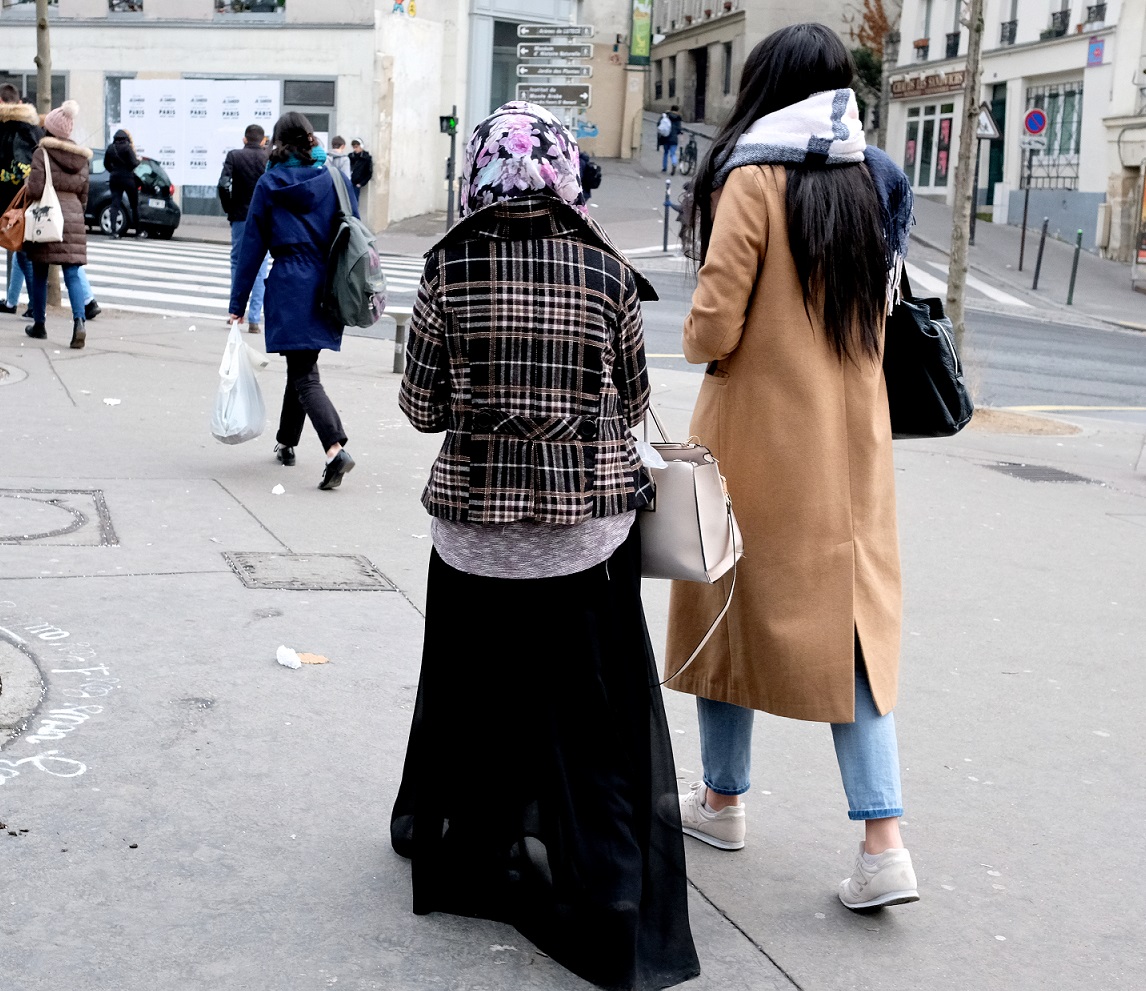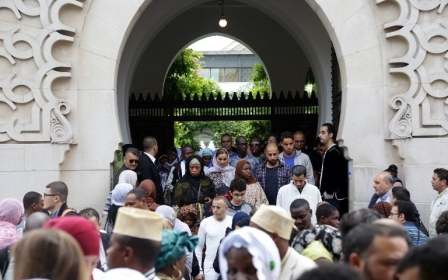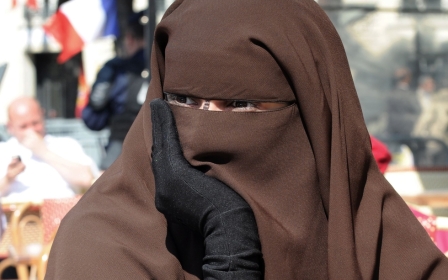Beyond stereotypes or prejudice, some French Muslim women choose to remove the veil

A 28-year old lawyer turned entrepreneur is speaking to Middle East Eye about how she came to take the veil off.
“I made the decision to stop wearing the veil in 2016, but I didn’t go through with it until 2017”, says Samia (not her real name), as she discusses the journey that led her to take the veil off.
As Samia experienced firsthand, the decision to leave the veil behind is no simple matter for either the women who chose to do so or the people in their lives.
“I started wearing the veil when I was 14 out of religious conviction,” Samia explained, adding her upbringing also played a role. “As a girl, I knew I would have to wear it one day.”
The veil in her family was a fact of life, and she had accepted the definitive nature of putting it on. “I grew up hearing that once I started wearing it, I shouldn’t take it off.”
New MEE newsletter: Jerusalem Dispatch
Sign up to get the latest insights and analysis on Israel-Palestine, alongside Turkey Unpacked and other MEE newsletters
Like many other young girls, Samia had to balance between her religious practice and her teenage life - a juggling act made harder by France’s restrictions on religious symbols in schools.
“In high school, I would take it off before class, then put it back on afterwards. It was awful. I remember complaining about it to my parents, but the idea of turning back seemed unthinkable to them.”
Samia didn’t object to the religious conventions at the time. “I was young”, she remarked, ascribing her “lack of character” to her youth. While Samia’s mother, who had been a teacher in the Maghreb, showed an interest in her evolving spirituality, relations with her father became increasingly strained.
In high school, I would take it off before class, then put it back on afterwards. It was awful. I remember complaining about it to my parents
- Samia, 28
“Before making my decision [to remove the veil], I discussed it with my father. We talked.”
Her father, a scientist by trade and an active member of the Muslim community, listened to his daughter, but was unconvinced.
“It was a big disappointment to him, particularly since I was the eldest. He thought I wouldn’t be setting a good example for my sisters,” she explained.
Samia’s husband intervened symbolically. “My husband had trouble understanding what I was doing, at first,” she said. “Especially since my father was going through him to try to dissuade me.”
The attempt was unsuccessful: last year, Samia went from wearing an Iranian-style chador to not wearing any form of head covering.
Faith and the veil
Nonetheless, Samia insists that “deciding not to wear the veil didn’t undermine my faith”.
“I read a lot of Fatema Mernissi, the Moroccan feminist writer and sociologist, and the Syrian poet, Adonis,” she said.
Whereas Adonis was very critical about the role of Islam in society, calling femininity in Islam a “licit and illicit object”, Mernissi, who died in 2015, wrote about the intrinsically political nature of veiling and unveiling.
“A veiled woman abides by the rule. The veil signifies ‘I move quickly and covertly through what I accept to be the masculine sphere’. A woman who throws off the veil claims her right to be a citizen, shaking the entire system as far as both gender and politics go”, Mernissi wrote in Dreams of Trespass - Tales of a Harem Girlhood.
The views of well-known figures of Islam in France - such as Omero Marongiu-Pierria, a sociologist known for his reformist opinions, and Imam Tareq Oubrou - ended up comforting Samia in her decision.
Oubrou is known in France for deconstructing the Islamic imperative to wear the veil. In a 2009 editorial in French daily Le Monde, the imam called to “Put your headscarf in your pocket”.
Today I refuse to convince anyone of anything with regards to my faith and my understanding of the texts. I remain a believer, but differently
- Maya, 27
Accused of setting the stage for the anti-Islamic crusade to ban the headscarf, Oubrou’s statements, often deliberately inflammatory, discredited him in the eyes of a significant part of the French Muslim community - including women who, at the time, were demanding the right to wear the headscarf as an affirmation of their basic freedoms.
Since the law against conspicuous religious symbols in public schools passed in 2004, the debate on the veil has been raging in the French public arena.
The veil - and the question of whether it is required in the Quran and the hadiths - has certainly become a bone of contention, not only between Muslims and secularists but among believers as well.
Consequently, the choice made by certain women to remove the veil has become not only indicative of their personal journeys within the French Muslim community, but also illustrates the pressures exerted in France against women who wear the hijab.
Between black and white
For Samia, her journey was not a rejection of Islam, but the reassertion of ritual and spiritual aspects of her faith. “At one point, I asked myself why I couldn’t take ownership of my own spiritual life,” she said.
In France the quarrel between detractors of the veil and its defenders, animated by their belief in the protection of freedoms, rapidly evolved into an black-and-white debate, within which the spiritual journeys of the women concerned did not factor in.
Two sides were drawn up and engaged in a fierce battle - drowning the veil under mounting layers of political debate and controversy, obliterating spiritual considerations all together.
Given the tense French context, it is hardly surprising that unveiling is seen as either an endorsement of secularism or a betrayal of the cause - that of the right to wear the veil and perhaps even of Islam itself. In both cases, the question of what Samia calls the “spiritual reappropriation of Islam” has been mostly dismissed or even denied.
A stranger wrote, ‘you will always be an Arab’, implying I was rejecting my Arab identity
- Maya, 27
The reactions Samia experienced clearly bear this out. “I’ve always been a very active member of my mosque. I have had a lot of Muslim women friends. When I removed my veil, I sensed reservations, and even disapproval, within my friend circle. To some extent, I was perceived as a traitor,” she said.
Hanane Karimi, a sociologist whose thesis addresses issues of veiling in France, points out that unveiling can be seen as either “a betrayal or a forfeiture” by fellow Muslims. “This is paradoxical given the fact that defenders of the veil insist on the right to wear it or not."
Maya*, age 27, suffered a similar form of exclusion. An academic with a degree in social sciences, the young woman wore the veil for fifteen years then decided, five years ago, to leave it behind. Her decision was met with a flood of insulting messages.
“One woman sent me a message on Instagram saying I was a disgrace to my grandmother. I also received an hour-long lecture on colonisation from a man who wrote to me ‘You will always be an Arab,’ implying I was rejecting my Arab identity”, she recalled, still indignant by the fact that complete strangers had gone out of their way to make such comments.
Maya has since come a long way and has come to realise that she “paved the way for other women, in some way”.
While no statistical studies are available on the subject, field work indicates that unveiling has emerged in France as an almost logical follow-up to the political arguments over the hijab in the public sphere. Could the decision to remove the veil be a symptom of such debates?
The jury is still out, but according to Samia and Maya, a general trend towards the disempowerment of women was one of the primary causes of their decision to take off the headscarf.
“After all those years with the veil, I realised I was being infantilised. I was seen as a sexless being,” Maya commented.
“By removing my veil, I rediscovered my femininity. The veil is not just about hair. It’s about curves, and appearances... It’s about a lot more.
“Some people would deny us the right to interpret the texts freely. Today I refuse to convince anyone of anything with regards to my faith and my understanding of the texts. I remain a believer, but differently,” she insisted.
Counting the cost
While the choice to remove the veil for Samia and Maya was indicative of a spiritual journey, it would be a mistake to think of unveiling as a homogeneous phenomenon.
“My fieldwork data reflects a number of reasons for unveiling,” Karimi pointed out.
“Unveiling is a rupture that raises a number of questions. However, the decision must be analysed as part of an individual’s journey process in which specific considerations come into play”.
According to the sociologist, the decision to remove the veil is primarily tied to social stigma.
“Wearing the veil in France comes at a professional, social, educational, and financial cost,” Karimi explained.
“This stigma can bring about two different types of reactions - either the reappropriation of the stigma, or a split from the group” as understood by late sociologist Abdelmalek Sayad. According to Sayad, a specialist on immigration, the experience of belonging to a minority can either lead to the reaffirmation of one’s difference, or, on the contrary, to a distancing from said group.
“Women in hijabs are tired of the stigma. Like many, they aspire to a level of anonymity in public,” Karimi remarked. This is why some are approaching the issue from a different angle, “shifting from conservative Islam to a more spiritual practice of religion”.
Wearing the veil in France comes at a professional, social, educational, and financial cost
- Hanane Karimi
Another reason is “the pragmatic approach”. Ines*, 33, removed the veil as a way to “be more useful to society”. The decision, in her case, was taken when she applied to a prestigious school as part of her higher education.
“I decided to remove my veil when I needed to take an oral exam to enter university.” She knew the jury would be strict on the issue of laicite - the French conception of secularism. “I didn’t want the focus to be on my veil. I wanted them to listen to what I had to say”.
In hindsight, “for me this item of clothing was a non-issue” she added. “In order to be heard, I had to erase all signs of being different.” Her decision was based on pragmatism, she said, referring to Prophet Muhammad. “The prophet took a pragmatic approach to life. Giving up the veil is also a choice that involves compromise”.
According to Karimi, Ines’s words show how “some women have reexamined the correlation between faith and the veil”.
“They have realised the fetishisation surrounding the veil, which introduces both an identitarian dimension but also translates into a reaction to a certain social stigma.”
The veil also conveys a strong symbolic and political message.
Karimi quoted one women interviewed as part of her research as saying that, for her, the choice to wear the veil was “because of [former French president Nicolas] Sarkozy”.
“The minute he started interfering with the religious lives of Muslims, I started wearing the hijab,” the woman reportedly told Karimi. The crackdown instigated by Sarkozy on ‘ostentatious religious symbols’ - widely seen as directly targeting France’s Muslim community - turned the veil from a religious item to a symbol of politics and dissent.
The Prophet took a pragmatic approach to life. Giving up the veil is also a choice that involves compromise
- Ines, 33
Such a line of thinking may seem surprising, even ironic. Since 2004 and the shunning of hijabi women in public spaces, the French political context has “played in favour of the veil,” despite the intent of such legislation being the defence a supposedly endangered laicite.
“The stigmatisation of a symbol associated with religion can either lead to its rejection or… its adoption,” Karimi concluded.
A decidedly counter-productive strategy that provides revealing insights on both the dynamics of veiling and unveiling.
- The article is based on an a translation of a story that was originally published by Middle East Eye's French website.
Middle East Eye delivers independent and unrivalled coverage and analysis of the Middle East, North Africa and beyond. To learn more about republishing this content and the associated fees, please fill out this form. More about MEE can be found here.








